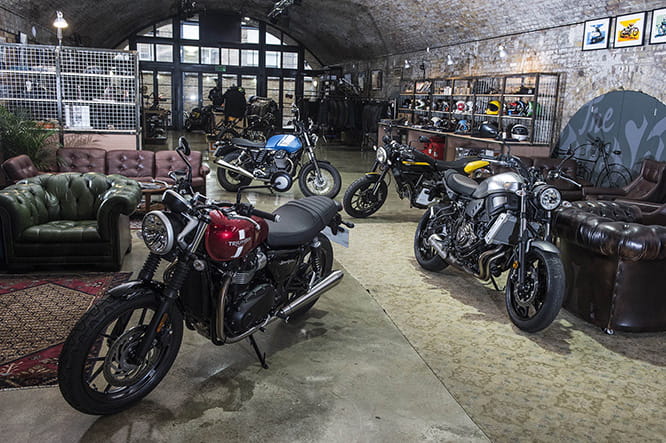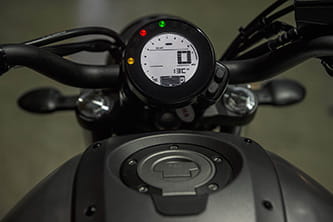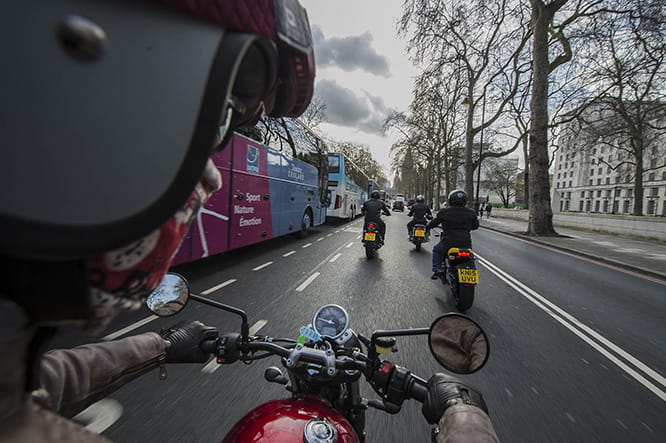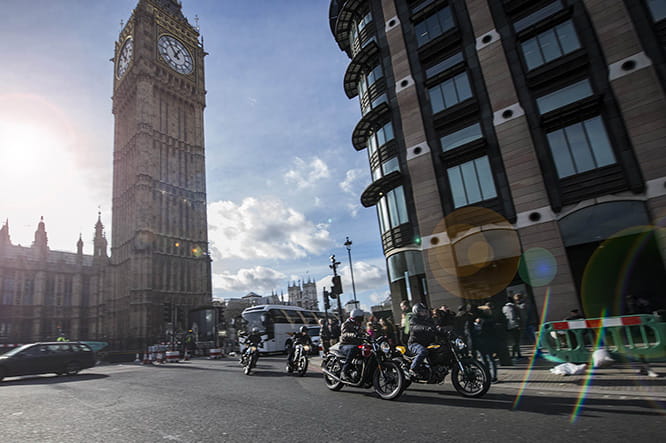We might not like to admit it, but motorbikes are pretty trendy right now.
Ok, so we’ve always known that they were awesome, but now the marketing men have spoken. They’ve created a new segment and it’s hard to turn a page in a bike magazine without seeing a young hipster trying to sell us a slice of on-trend Sixties inspired retro cool. So to see if these bikes have the substance to match their style, we took 2016’s new contenders – Triumph’s Street Twin and the Yamaha XSR700 – up against Ducati’s class leading Scrambler and a wildcard in Moto Guzzi’s traditional V7.

From the underground
Sure, there have always been ‘retro’ bikes, but until a certain point in time they’d always just been traditional motorcycles, a ‘standard’ in American parlance, that were typically sold in small numbers and ridden by old blokes and earnest commuters.
The idea that retro could be cool came alive when Triumph brought out the ‘new’ Bonneville in late 2000. With little fanfare, here was a bike that not only appealed to geezers that rode them back in the day but also found a cult following on the streets of Paris and Milan as the choice of young fashionista looking for something special with which to tackle the daily commute.
Cottoning on to the concept that heritage sells in the 21st century, Triumph’s marketeers exhumed the spirit of Steve McQueen to launch the Scrambler in 2006, a bike that dripped Sixties So Cal desert sled cool from its core. Not only was it a fairly good seller, it came with a whole catalogue of (no doubt profitable) accessories to give the owners opportunities to open their wallets and personalize their steeds.
More recently, the retro bike scene has grown a beard and emerged from the underground. A host of boutique custom shops, such as Australia’s Deus Ex Machina, Britain’s Spirit of the Seventies, Italy’s Mr. Martini and numerous American customisers came to the fore, their work showcased by outlets such as Bike EXIF and Bike Shed MCC.
That spirit has now been distilled and neatly packaged by the motorcycle marketing men (and women) with a range of big selling shed-built-in-a-factory models aimed at those who like the idea of looking cool, but are not so keen on getting dirt under the fingernails
The contenders
Ducati Scrambler Full Throttle



While Triumph arguably invented the ‘modern’ retro bike with their 2006 Scrambler, it was Ducati’s marketing department that took it to a whole new level with the launch of its own model of the same name last year.
Presented amid a storm of publicity (and a somewhat bizarre ‘Land of Joy’ campaign) the Italians launched the Scrambler with four variants to suit riders’ individual taste and wallets, although all bikes shared the same 803cc aircooled V-twin motor, putting out a claimed 75bhp. For 2016, the Scrambler sub range has been increased to six models, with the mechanically identical Flat Track Pro and entry level 400cc Sixty2, which has primarily been introduced to appeal to emerging markets and those with capacity restrictions on licences.
Our test model is the £8531 Full Throttle version, with prices starting at £7386 for the basic Icon spec.
Moto Guzzi V7 II Special



Moto Guzzi is a brand that has always stood out from the pack, not least due to its insistence in powering its bike by transversely mounted shaft driven V-twins.
It’s a company that until recently made traditional (read outdated) designs that appealed to a few enthusiasts but now, under the ownership of the giant Piaggio conglomerate, the company is broadening its appeal while remaining true to its traditional values.
The V7 was launched in 2008 with this current updated V7 II coming in under the radar last year. Promoted by actor Ewan McGregor, the V7 II features technology such as ABS brakes, traction control and a new-for-Guzzi six-speed gearbox, however it still only has two valves per cylinder, and these are activated by pushrods (yes, pushrods). This is a proper old school kind of cool.
Like all the bikes on test, there are numerous variants and accessories available to allow the rider to customize the machine to their individual tastes. In the case of the V7, four versions roll out of the showroom, from standard roadster to single seat cafe racer and a scrambler variant with high level exhausts. We’ve tested the £7635 V7 II Special, although Guzzi will sell you a ‘Stone’ version for £500 less, which comes with alloy (rather than spoked) wheels and single colour paintwork.
Triumph Street Twin



With the old Bonneville range looking and feeling long in the tooth, Britain’s kings of cool have revamped their classic range for 2016 with a completely new platform to replace the aging 865cc air/oil cooled twins.
The Street Twin is the entry level model, powered by an all-new 900cc parallel twin that makes it the biggest capacity bike on test.
As standard the £7300 Triumph is elegant but a bit vanilla in its looks, however with a massive range of over 150 accessories for the Street Twin alone, this is a bike that has been built for personalization. Triumph's designers have clearly been inspired by the whole Bike Shed vibe and, if your credit card can cope, the Street Twin can easily be given a mild ‘brat’ look, or can be transformed into a scrambler style machine with its high level exhausts, stripped back rear bodywork and sumpguard.
Despite the traditional looks, the Street Twin is packed with the latest technology, including ride by wire throttle and traction control, as well as neat touches like an USB charging port.
Yamaha XSR700



Yamaha are the first of the Japanese manufacturers to grow beards and head down to the tattoo parlours, and boy do their marketing gurus seem to be having a whale of a time.
They’ve dreamed up the new ‘yard built’ range, coming out of the workshops of the mythical ‘Faster Sons’. While it all sounds a bit contrived, they’re turning out some pretty cool motorcycles in the form of the XSR700 and XSR900.
While Triumph’s engineers have been heavily influenced by the vibrant European custom scene, Yamaha have got into bed with American guru Roland Sands to develop not only the bikes, but also the obligatory range of accessories that allow for your own motorcycle to be further customized in your own shed (or indeed the comfort of your local Yamaha dealer).
What you’ve got under the skin of the XSR range are essentially the excellent MT-07 and MT-09, two of the best modern bikes on the market. At £6249, the XSR700 is by far and away the cheapest bike on test. But how will it stack up on the road?
First impressions
Picking up the bikes at London’s uber-cool Bike Shed MCC, it’s the Ducati and Guzzi that make the first connection with me.
Surrounded by some of the best customs in the capital, the Ducati stands out with its vibrant yellow paintwork and beautiful finishes, while the V7 just looks like an authentic classic that belongs in a museum.
That big coffin tank and sticky-out cylinders give the Guzzi a real presence that the others can’t match. The first bike I ever rode pillion on was an early Le Mans when I was at primary school and I can’t wait to ride this one, even though a look at the spec sheet suggests it ain’t going to be all that out on the road.

By contrast, the Triumph and Yamaha are leaving me a little cold. I have a real connection with both brands and love them dearly, but neither bike is really talking to me. The Triumph looks a little dull. It’s tiny. I’m tiny, so that’s good (for me at least) but it feels heavy to paddle around. The detailing is beautiful, the little logo in the headlight, the LED rear light, all belie the budget price, but it feels like the entry level model it is, and it doesn’t speak to me like the tricked up models I saw at the winter shows. Some girls look better without makeup. This one doesn’t.
But the XSR700 is annoying me. I don’t really know what to make of it. The aluminum silver paint finish is delicious, I could eat it up, but the bike has barely turned a wheel and there’s already a little mark in it. The brown seat with embossed logo is super cool, as is the LED rear light and trick little dashboard, but together they just look like they’ve been thrown at a modern bike. The other bikes have beautiful engines that have been designed to flirt with you and tempt you with their retro charm, but the motor dominates the side profile of the XSR and it just ain’t pretty. And that radiator? I ain’t digging that angle either…

On the road
With the entire Bike Social team out on the test there’s plenty of time to jump between the bikes and share experiences.
In addition to me (short and old), we’ve got Potski (tall and one of the world’s most experienced road testers), Michael (wide range of experience and former London commuter) and Oli (relatively new rider still earning his spurs). These bikes have been designed to be accessible, being easy enough to ride for young and inexperienced riders, while providing enough go to appeal to lifelong motorcyclists.
Starting out on the Triumph, I immediately feel at home filtering through the London streets. At 214kg, it is by far and away the heaviest of the four, but with a 750mm seat height, it is easily the lowest too. Because that seat is also so narrow, the Street Twin feels like the lowest non cruiser that I have ever ridden. I’ve resisted the term ‘girl's bike’ up ‘till now but there, I said it. It really is so accessible and ridiculously easy to ride through the city streets thanks to the mega torquey motor that just drives from zero.
Jumping to the Guzzi provides a culture shock. At 790mm, the seat is a little taller than the Street Twin’s, but its wider and that makes a big difference. None of the four bikes are tall though, and the immediate feeling upon riding this is the connection between the engine and rider. Where the Triumph’s modern twin is a bit on the bland side, the Guzzi is the complete opposite. It’s full of character, the big pistons rock from side to side and the shaft drive rises on acceleration and drops under braking. It’s crap but I love it. I know that I am riding a motorcycle, even though it’s a bit of a pain in the arse through traffic. We also discovered fairly quickly that the finish ain’t that great. Sure some of the components (in particular, the rear brake lever) look like they were machined by the fourth year metalwork class, but we didn’t expect one of the side panels to abandon ship a few miles after departure. Oh well, at least we jettisoned a little weight!

Talking of weight, I am still trying to work out just what the Triumph is made of. It rides ok, but it must be machined from metal heavier than Spinal Tap. Guzzi claim 205kg for the V7, which feels about right, and I’d say five of those kilos are probably the extra fuel carried in the large 21 litre tank (the Triumph has the smallest with a diddy little 12 litre job).
By contrast, the Ducati feels waif like. As with the Guzzi, it’s got an aircooled engine that’s full of charm, and although it’s a bit lumpy around town, there are understandably none of the torque reactions that affect its fellow Italian. The bars are high and wide, like an off-roader, but the seat is narrow and manageable, great for shortys like me. Even in town it feels the most alive. It shares its key claimed specs with the Yamaha (75bhp/50ft-lb/186kg) and this is borne out on the road. The Yamaha feels really nice, unsurprisingly like an MT-07, but the Scrambler oozes character. It makes a lovely booming noise. Bystanders turn their heads. You look at your reflection in shop windows. It even caused a car crash when the driver in the next lane spent more time admiring the Ducati and Triumph next to him, and less at the driver in front applying his brakes. Oh well, the world probably needs less Ford Fiestas anyway.
The open road
Like all the bikes on test, the Yamaha is perfectly at home in the city. Sure it has the tallest seat of the four, but at 815mm (and narrow to boot) most riders will be able to get on fine with the XSR.
It’s the quickest of the quartet. The chassis is composed enough, but push on and rear suspension in particular starts to show its budget spec. Grip from the Pirellis (all four feature Pirelli tyres of some description, incidentally) was good, even in the cold conditions we rode in, and the brakes fell like the strongest of the four (the XSR is the only bike with a twin front brake set-up). Going quick is not really the point of these bikes, but it probably says a lot about the Yamaha and its MT-07 roots that is the one bike where you really start analyzing its sporting credentials. It’s a bike that becomes undressed at speed, in as much as it really doesn’t feel the slightest bit retro when you open the throttle.

The opposite is true of the Guzzi. Riding the across the frame V-twin really changes your mindset. It’s lovely, in a plodding sort of way. It only delivers a claimed 47bhp, making it A2 licence compliant out of the box, and its enough to have fun on the open road. It’s still a Guzzi though and you really feel that you are riding a motorbike. The gearbox, while not as agricultural as previous Guzzis I have ridden, is still a bit clunky. Oli summed it up best when he said that the V7 was like riding a classic bike, while the others were just modern bikes that have a retro look. He’ll go far that lad, ‘cos he hit the nail right on the head with that one.
While the Triumph was my favourite in town, it’s limitations are exposed on the open road. That torquey motor runs out of revs really quickly. There is no rev counter (there’s no need) but claimed peak power of 54bhp comes in at just 5900rpm. The weight makes it feel very stable on fast roads, but it’s no super precise weapon. It feels a touch ponderous and ground clearance is at a premium, but its perfectly adequate, and those looking for a more thrilling ride will be catered for by the upcoming 1200cc Bonneville range.
One area where I did mark the Triumph down through was on motorway work. None of these bikes have any meaningful wind protection, but I found the Street Twin gave my upper body a particularly hard work out. And it’s the only bike on test to have a five speed gearbox. An overdrive sixth would have been welcome.
The lightweight Ducati is mega fun on the open road though. It’s also not fantastic in a straightline, but through the twisties it’s a real hoot to chuck through the corners, even wearing off-road styled Pirelli MT60 RS rubber. A colleague also told me that it does the best wheelies, but I don’t know anything about that…

Costs
It’s a clear win for the XSR when it comes to purchase price. At £6249 on the road, it’s over a £1000 cheaper than the others and serious value for money. On test, we saw an average of 51mpg in mixed conditions, second only to the Triumph.
For day-to-day running costs, its hard to beat the Street Twin. Prices start at £7300 and frugality could almost be the Street Twin’s middle name. We recorded 65mpg on test, significantly better than its rivals, while Triumph has also sharpened up the service intervals on its new model, with a visit to the dealership only required every 10,000 miles.
As tested, the Ducati is the most expensive bike out of the showroom – but that is only because the manufacturer provided us with the top spec £8351 Full Throttle version. At £7386, the entry level Icon version (which comes minus the Full Throttle’s stacked Termignoni cans and other detail changes, such as the less fancy seat) is bang on the money with the other Euros. Fuel consumption on test was 47mpg, with service intervals at the industry standard 6000 miles.
The Guzzi also returned 47mpg and going for the base spec Stone version will make it the cheapest of the European challengers at £7135. It does have the smallest UK dealer network though, meaning that you might have to travel for a bit to get your Guzzi serviced.




The cool factor
Stopping off at the brilliant Krazy Horse in Bury St. Edmunds (a super cool dealer-cum-cafe specialising in custom bikes) towards the end of our two day test confirmed what we all thought from the beginning: when it comes to pulling a crowd, there was only one winner – the Scrambler. It’s the bike that drew the most admiring glances and started the most conversations on the way. I’m sure it’ll help you make friends at a bike meet. And it sounds great to boot.
The Triumph and Moto Guzzi are not so much cool as authentic. They are the bikes that old guys gravitate to as they take a trip down memory lane. The Triumph needs a bit of dressing up to give it the X Factor, but having seen what can be done with the Triumph accessory range, I reckon a well done Street will make quite a statement. The Yamaha tended to get overlooked in the shadow of the others, but it is still a pretty sweet daily ride and I can see loads of them being sold. It just feels to me like a bike designed by marketing men rather than engineers, and that’s never cool.

Verdict
Picking a winner is as much a personal thing as anything else. On paper, and on the road, the Guzzi comes last, although that doesn’t mean that it’s not without merit. It’s a charming old plodder that I’d happily own, love and cherish for years and years to come. It’s not so much a retro as a classic straight from the factory. I love it, but in this company it’d be a purchase made from the heart rather than the head.
The Yamaha is a fine bike that just doesn’t quite have the authenticity to match the Ducati or the Triumph. If you’re thinking about buying an MT-07 but like the look of the XSR700 more, buy it! I found it hard to create an emotional bond with the Yamaha, but it’s the bargain of the group and probably the best bike dynamically. On paper, it wins this test, but all of us (with the possible exception of Michael) felt that it just lacks something that we couldn’t quite put our finger on.
For city riding, I’d choose the Triumph – although I’m not convinced my colleagues would agree. It’s a fair bit heavier than the others, even the carved-from-granite Guzzi, but the seat height is so low that it carries its weight well. The engine is the biggest of the four and really creamy at the bottom end. It’s beautifully built and full of great modern technology that belies the classic looks, but get out on the open road and the Street Twin’s weaknesses are exposed. That motor runs out of revs real quick and the chassis, adequate as it is, feels more budget than either the Scrambler or XSR700. It’s a great entry level bike and I’m really looking forward to riding the full fat 1200 Bonnevilles when they hit the showrooms in the coming months.
The Ducati is the star of the show though. Dynamically, it feels the quickest and the lightest, and unanimously we agreed it was the coolest. We may not like to admit it, but for many of us, that’s the total attraction of this kind of bike. Park it up and the Scrambler never fails to draw a crowd. Climb on board and suddenly you’re Steve McQueen. It may have been conceived by marketing men, but the Scrambler has most definitely been brought to life by engineers who live and breath motorcycles. Oh yeah, this is one kick ass motorcycle.

TECHNICAL SPECS
|
|
Ducati Scrambler Full Throttle
|
Moto Guzzi V7 II Special
|
Triumph Street Twin
|
Yamaha XSR700
|
|
Engine
|
Air-cooled, V-twin
|
Air-cooled, V-Twin
|
Liquid-cooled, eight valve, SOHC, parallel twin
|
Liquid-cooled, eight valve, DOHC, parallel twin
|
|
Capacity
|
803cc
|
744cc
|
900cc
|
689cc
|
|
Power
|
75 bhp @ 8250 rpm
|
46.9 bhp @ 6250 rpm
|
54 bhp @ 5900 rpm
|
75 bhp @ 9000 rpm
|
|
Torque
|
50 ft-lbs @ 5750 rpm
|
43.5 ft-lbs @ 3000 rpm
|
59 ft-lbs @ 3230 rpm
|
50.2 ft-lbs @ 6500 rpm
|
|
Suspension
|
Front: Upside down Kayaba 41 mm fork. 150mm travel
Rear: Kayaba rear shock, pre-load adjustable. 150mm travel
|
Front: 40mm hydraulic telescopic front fork. 130mm travel
Rear: Die cast light alloy swing arm, twin shock absorbers, preload adjustable. 96mm travel
|
Front: Kayaba 41mm forks, 120mm travel
Rear: Kayaba twin shocks with adjustable preload, 120mm rear wheel travel
|
Front: Telescopic forks with 90mm travel
Rear: Swingarm (link type) with 130mm travel
|
|
Brakes
|
Front: Single 330 mm disc, radial four-piston caliper with ABS
Rear: 245 mm disc, one-piston floating caliper with ABS
|
Front: 320 mm stainless steel floating discs, Brembo calipers with four differently sized opposed pistons
Rear: 260 mm, stainless steel disc, floating caliper with two pistons
|
Front: Single 310mm disc, Nissin two-piston floating caliper, ABS
Rear: Single 255mm disc, Nissin two-piston floating caliper, ABS
|
Front: Hydraulic dual disc, Ø 282 mm
Rear: Hydraulic single disc, Ø 245 mm
|
|
Dimensions
|
L: 2165mm
H: 1150mm
Wheelbase: 1445mm
|
L: 2203mm
H: 1115mm
Wheelbase: 1449mm
|
L: 2090mm
H: 1114mm
Wheelbase: 1439mm
|
L: 2075mm
H: 1130mm
Wheelbase: 1405mm
|
|
Fuel Tank
|
13.5 litres
|
21 litres
|
12 litres
|
14 litres
|
|
MPG (on test)
|
47
|
47
|
65
|
51
|
|
Seat height
|
790mm
|
790mm
|
750mm
|
815mm
|
|
Approx. Weight (wet)
|
186kg
|
205kg
|
214kg
|
186kg
|
|
Price
|
£8351
|
£7635
|
£7300 (add £120 for red or silver)
|
£6249
|
Massive thanks to our friends at The Bike Shed Motorcycle Club and Krazy Horse for their perfect hospitality.
KIT CREDITS
Marc Potter
Helmet: Bell Custom 500
Jacket: AlpineStars Oscar Monty Leather Jacket
Jeans: AlpineStars Oscar Charlie Denim Pants
Boots: AlpineStars Oscar Monty Riding Shoe
Michael Mann
Helmet: Davida Ninety-Two
Jacket: Resurgence Rocker Olive Green
Jeans: Resurgence Skinny Cafe Racer
Boots: TCX X-Street W/P
Gloves: Alpinestars Oscar Robinson
Paul Taylor
Helmet: Schuberth M1
Oli Rushby
Jacket: Richa Retro Racing
Jeans: Richa Original Jeans
Boots: TCX XFive WP

























